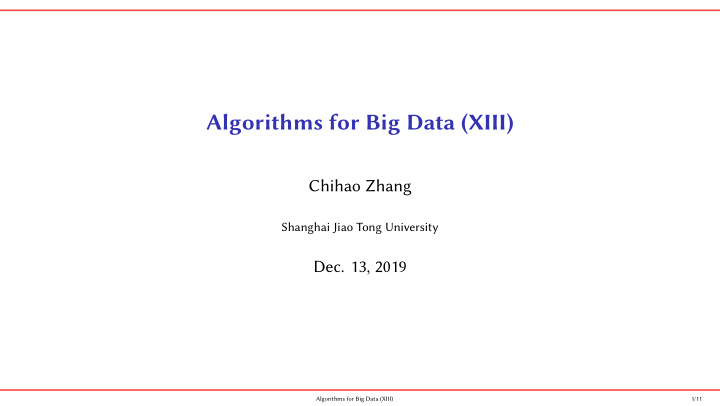



Algorithms for Big Data (XIII) Chihao Zhang Shanghai Jiao Tong University Dec. 13, 2019 Algorithms for Big Data (XIII) 1/11
Review We studied random walks on general graphs using spectral decomposition. We derived bounds on the cover time of random walks. Algorithms for Big Data (XIII) 2/11 We introduced the notion of electrical networks.
Electrical Network Now we formally justify the electrical network argument used last week. Ohm’s law is used to define the potential drop between two ends of an edge. Algorithms for Big Data (XIII) 3/11 For an edge with weight w e , we define its resistance r e = w − 1 e . For an edge { u, v } , we can assign numbers i ( u, v ) = − i ( v, u ) as the current on the edge. The collection of currents is required to satisfy Kirchhofg’s law.
Matrix Form It is instructive to express physical laws in the matrix form. Algorithms for Big Data (XIII) otherwise. 4/11 We use an ordered pair ( u, v ) satisfying u ≤ v to represent an edge { u, v } ∈ E . The signed edge-vertex adjacency matrix U ∈ { 0, 1, − 1 } E × V is defined as 1 if w = u U (( u, v ) , w ) = − 1 if w = v 0 Let W ∈ R E × E be diag ( w ( e 1 ) , . . . , w ( e | E | )) .
Algorithms for Big Data (XIII) It holds that 5/11 We use i ∈ R E to denote the vector of currents, v ∈ R V to denote the vector of voltages. i = W · U · v . We use i ext ( u ) to denote the amount of current entering u externally. Then i ext ( u ) = ∑ v ∈ N ( u ) i ( u, v ) , and i ext = U T i = U T · W · U · v . If i ext ( u ) = 0 , we call it a internal node, otherwise, we call it a boundary node.
Graph Laplacian Using the decomposition, the equation becomes to Algorithms for Big Data (XIII) 6/11 The matrix L ≜ U T WU is again graph Laplacian. Consider the spectral decomposition of L : ∑ L = λ i v i v T i . i>1 ) ( ∑ ∑ ∑ , a i v i = λ i v i v T b i v i i i ≥ 1 i>1 i ≥ 1 where i ext = ∑ i ≥ 1 a i v i and v = ∑ i ≥ 1 b i v i .
We shifu v so that to the current leaving the network! Algorithms for Big Data (XIII) 7/11 Therefore, we must have a 1 = 0 , which means the current entering the network is equal Define the Moore-Penrose pseudo-inverse of L L + = ∑ λ − 1 i . i v i v T i>1 Given i ext , we can compute v as long as we can compute L + . v = L + i ext .
Effective Resistance We are now able to formally define efgective resistance. On the other hand, Algorithms for Big Data (XIII) 8/11 R eff ( u, v ) ≜ ( e u − e v ) T L + ( e u − e v ) . To see this, assuming one unit of current enters u and leaves v : v = L + ( e u − e v ) . v ( u ) − v ( v ) = ( e u − e v ) T v = ( e u − e v ) T L + ( e u − e v ) .
Examples: Series and Parallel graphs. Then we can write Algorithms for Big Data (XIII) 9/11 Note that L + is positive semi-definite, we can define L + /2 = ∑ λ − 1/2 v i . i>1 v ( u ) − v ( v ) = ( e u − e v ) T v = ( e u − e v ) T L + ( e u − e v ) = ∥ L + /2 ( e u − e v ) ∥ 2 2 .
Approximating Effective Resistance Theorem Algorithms for Big Data (XIII) satisfying 10/11 Recall in Lecture 6, we learnt: Directly computing efgective resistance requires to compute L + , which is costly. We can view L + /2 e u and L + /2 e v as two vectors in R n and approximate their distance using metric embedding technique. For any 0 < ε < 1 2 and any positive integer m , consider a set of m points S ⊆ R n . There exists an matrix A ∈ R k × n where k = O ε − 2 log m ( ) ∀ x , y ∈ S, ( 1 − ε ) ∥ x − y ∥ ≤ ∥ A x − A y ∥ ≤ ( 1 + ε ) ∥ x − y ∥ .
Algorithms for Big Data (XIII) 11/11 In our proof of JLT, each entry of the matrix A is from N ( 0, 1/k ) . We only need to show how to compute AL + /2 efgiciently… Let L ′ ≜ W 1/2 U , then ( L ′ ) T L ′ = L + . Therefore ∥ L ′ ( e u − e v ) ∥ 2 2 = R eff ( u, v ) . We only need to solve d -linear equations in L to obtain AL ′ L .
Recommend
More recommend